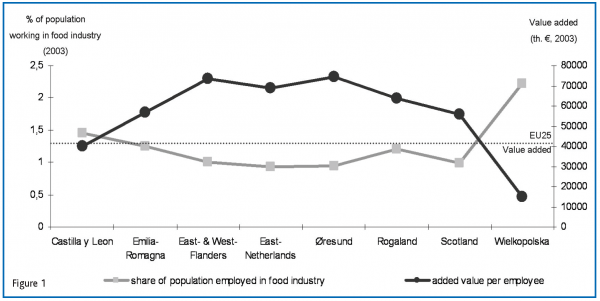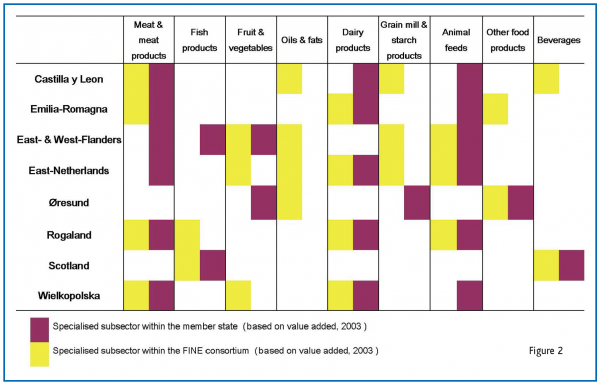Reinforcing innovation clusters in the European food industry
- Like
- Digg
- Del
- Tumblr
- VKontakte
- Buffer
- Love This
- Odnoklassniki
- Meneame
- Blogger
- Amazon
- Yahoo Mail
- Gmail
- AOL
- Newsvine
- HackerNews
- Evernote
- MySpace
- Mail.ru
- Viadeo
- Line
- Comments
- Yummly
- SMS
- Viber
- Telegram
- Subscribe
- Skype
- Facebook Messenger
- Kakao
- LiveJournal
- Yammer
- Edgar
- Fintel
- Mix
- Instapaper
- Copy Link
Posted: 6 November 2006 | Bert Vermeire, Xavier Gellynck, Ghent University and Joep Koene, Development Agency East Netherlands NV | No comments yet
Until recently, the food industry was considered to be a traditional industrial sector with a low capacity for innovation, mainly due to the ‘basic’ character of food products. However, the globalisation of the food market in addition to changing consumer preferences profoundly affects the food sector. Nowadays, innovation is put forward as the main instrument to generate added value and to stay competitive within the fast evolving global food market. Innovation also plays a central role in European policy, put forward in the Lisbon Agenda (2000) setting the objective of becoming the most competitive and dynamic knowledge-based economy in the world, with innovation as the key instrument.
Until recently, the food industry was considered to be a traditional industrial sector with a low capacity for innovation, mainly due to the ‘basic’ character of food products. However, the globalisation of the food market in addition to changing consumer preferences profoundly affects the food sector. Nowadays, innovation is put forward as the main instrument to generate added value and to stay competitive within the fast evolving global food market. Innovation also plays a central role in European policy, put forward in the Lisbon Agenda (2000) setting the objective of becoming the most competitive and dynamic knowledge-based economy in the world, with innovation as the key instrument.
Until recently, the food industry was considered to be a traditional industrial sector with a low capacity for innovation, mainly due to the ‘basic’ character of food products. However, the globalisation of the food market in addition to changing consumer preferences profoundly affects the food sector. Nowadays, innovation is put forward as the main instrument to generate added value and to stay competitive within the fast evolving global food market. Innovation also plays a central role in European policy, put forward in the Lisbon Agenda (2000) setting the objective of becoming the most competitive and dynamic knowledge-based economy in the world, with innovation as the key instrument.
‘Regions of Knowledge 2’ is one of the instruments the EC provides to realise this objective. It aims to promote increased and improved regional investment in R&D through intensive and structurised collaboration between regional stakeholders.
In this context, Food Innovation Network Europe (FINE) was created. It comprehends a network of European food regions joining forces to increase innovation by enhancing exchange and collaboration between the stakeholders of the food industry. The following regions collaborate in this project:
- Castilla y Leon (Spain)
- Emilia-Romagna (Italy)
- East- and West-Flanders (Belgium)
- East-Netherlands (The Netherlands)
- Øresund (Denmark & Sweden)
- Rogaland (Norway)
- Scotland (UK)
- Wielkopolska (Poland)
Figure 1 describes the differences between the regions in terms of value added per employee and employment as a share of the total regional population.
All FINE regions have common regional characteristics: a food sector playing an important role in the regional economy; the presence of a strong agricultural sector and other specialised suppliers of the food industry; a high level of food-related knowledge in the region; the presence of public support for the food industry and, finally, local networks linking the different actors together. It is believed that when an intense interaction between the different stakeholders exists, the conditions are fulfilled to create a regional dynamic of food innovation, increasing the competitiveness of the food firms and the overall economic performance of the region.
The project includes the following phases: first, a profound analysis of the current situation takes place, whereby a number of strategic options are formulated based on the potential of each region. Second, the FINE network sets a number of strategic goals which are translated in an Action Programme. Third, this Action Programme will lead to projects on the level of the network and of the individual region, with the ambition of developing FINE into a long- term innovation network.
In September 2006, the first stage of the project was finalised, enabling a number of observations about the current state of food clustering in the food industry to be made. These preliminary findings are based on a stakeholder consultation round among 87 entrepreneurs, policymakers and representatives of regional development organisations and networks. The findings can be summarised as follows:
- The strong position of the food industry is associated with the global meat chain (including dairy and animal feed production) in 6 out of 8 FINE regions. It corresponds with a strong agricultural meat production (Figure 2)
- R&D is a collaborative process between in-house R&D activities and external research cooperation. The findings illustrate that R&D in the food industry is built on a strong knowledge base shared with a diversity of stakeholders. However, the transformation of this knowledge into successful innovations is hindered by inefficiencies in communication between the stakeholders. Hereby, three factors are important: Firstly, differences in paradigm between entrepreneurs and academics; secondly, an individualistic orientation of some of the entrepreneurs and the lack of openness in cooperation and thirdly, the absence of coordination between different networks
- Increasing the share of high added-value products is often put forward as the primary focus of innovation. However, the production of commodities remains very important in the FINE regions. This implies that the choice for adding more value implies a profound restructuring of the food firm (and sector). Strategy-making involves making choices between both paradigms: high-added value products or commodities production
- Regional policy plays an important role in R&D and innovation. However, its potential is not fully realised. Stakeholders indicate the presence of a large number of initiatives supporting innovation, originating from the EU level and being implemented at the regional level. However, the success of these initiatives is tempered by negative effects of other policy measures, indirectly related with innovation such as the lack of flexibility in the labour market, administrative obligations and the difficult immigration of knowledge workers. Effectiveness of innovation policy depends upon its coherence with other policy domains which are only indirectly related to innovation policy
- Industrial policy in the EU is a mixture of vertical and horizontal measures. Hereby, the question arises how these measures contribute to the development of specialised stocks of knowledge and consequently of successful clusters. On the one hand, in most region’s vertical measures for the food industry are limited in number and scope. On the other hand, horizontal measures can also contribute to the development of specialised knowledge by supporting firm cooperation and interdisciplinary cooperation
The eight regions united in the FINE project host a huge potential for the food business. However, there is an urgent need to enhance interaction between the involved stakeholders. The analysis confirms the presence of high quality resources, but suggests improvements to use these in a more efficient way. Hereby, the focus should be on enhancing communication and coherence between stakeholders and initiatives.








